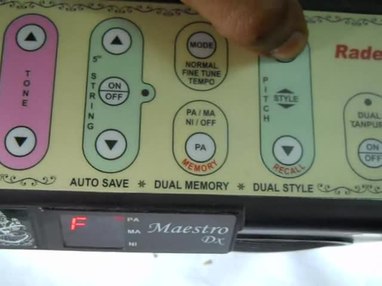Electronic tanpura
This article includes a list of general references, but it remains largely unverified because it lacks sufficient corresponding inline citations. (July 2020) |
An electronic tanpura is an electronic instrument that replicates the sound of an Indian string instrument known as the tanpura (tambura), used to provide a constant drone to accompany another's vocal or instrumental melody.
Terminology[edit | edit source]
It may also be called an electronic tambura, electronic shruti box, or simply shruti box.
Function[edit | edit source]
In Indian music, the drone is a basic function of the music. The development of a raga, any composition or song within raga presupposes and requires the continuous sounding of the key-note, its octave and another tone, usually the fifth or fourth. Traditionally drone is often provided by one or more tanpura player(s), especially for vocal performances.
The electronic tanpura was created as a marketable, practical solution for instrumentalists, having their hands otherwise engaged, who cannot readily avail themselves of able tanpura players for their long hours of private practice. Generally, the electronic tanpura has one or more dials to control the tone and volume, and may have other switches and buttons that allow a certain pitch and volume to be saved and used again at a later time. The range is usually one to two octaves.

History[edit | edit source]
The electronic tanpura was first invented by Mr. G. Raj Narayan in 1979,[1] an engineer-flautist from Bangalore, India, and demonstrated at the annual conference of the Music Academy Chennai in December that year. The products were manufactured by the company he founded, Radel Electronics. The first versions were created with the technology then available, using discrete components and transistors. In the late 1990s, these gave way to models using sampled recordings of the traditional tanpura on a chip. In the 2000s, tanpura mobile apps have been produced. In 2016, a mathematical model of tanpura was developed at the Sonic Arts Research Center of Queen's University Belfast.[2] In 2018, Pocket Shruti Box, an Android app that implemented this model, was released.
Criticism[edit | edit source]
For many musicians the electronic tanpura is a practical commodity, delivering a passable substitute for a live tanpura. It is easier and less expensive than maintaining a live tanpura player. However, some musicians consider the electronic tanpura a poor substitute when compared to a good tanpura in expert hands, as the tones it creates lack the dynamics of a live musician, producing a mechanical, repetitive sound.[3][4] However, considering the fact that the tanpura itself is used by plucking it in a repetitive manner for the sole purpose of providing the accompanying drone, this argument does not hold up well. Further, with the latest technology making it possible to digitally record the sound of the acoustic instrument, the digital versions are not only accepted but widely used.[citation needed]
See also[edit | edit source]
References[edit | edit source]
- ↑ Vijaya Ghose (1994). Limca Book of Records. Bisleri Beverages Limited. p. 127. The first electronic tanpura was also developed by Mr. G. Raj Narayan in December 1979
- ↑ van Walstijn, Maarten; Bridges, Jamie; Mehes, Sandor (2016). "A Real-Time Synthesis Oriented Tanpura Model". Proceedings of the 19th International Conference on Digital Audio Effects (DAFx-16).
- ↑ Spaink, Martin (2003). "Some reflections on the use of Electronic Substitute Tanpura and the intricacies of proper tanpura tuning". Retrieved 25 June 2007.
- ↑ Sruti. P.N. Sundaresan. 2006. p. 71. Any model electronic tanpura produces a sound that is necessarily artificial, which is the opposite of artistic. The electronic substitute has no artistic value and has nothing to teach us but repetitive unnatural boredom.

